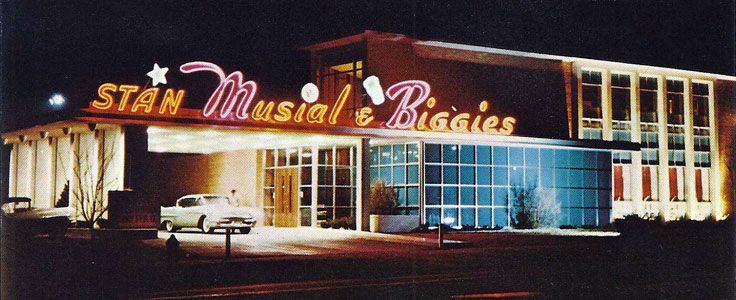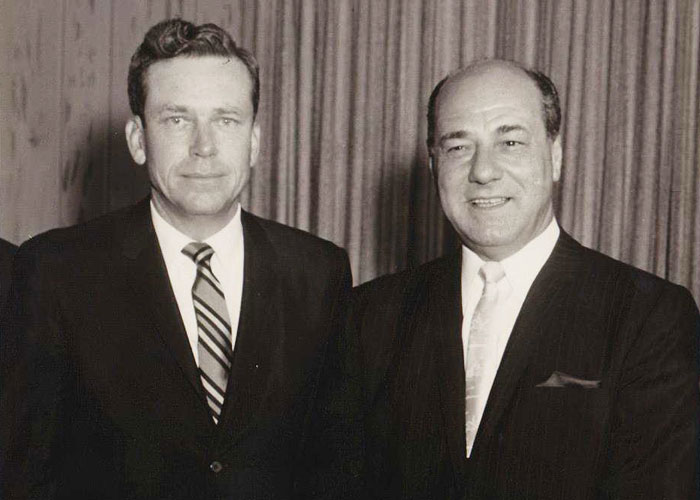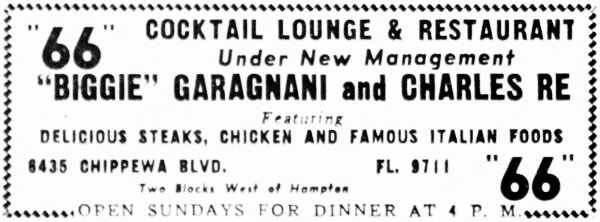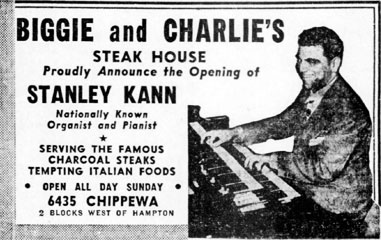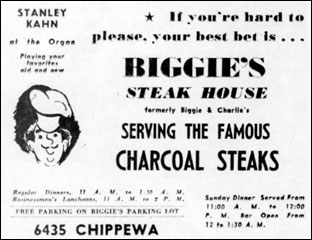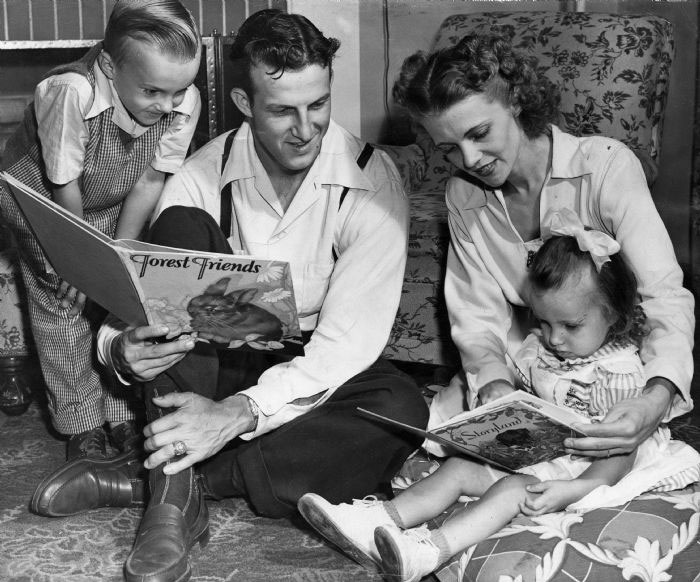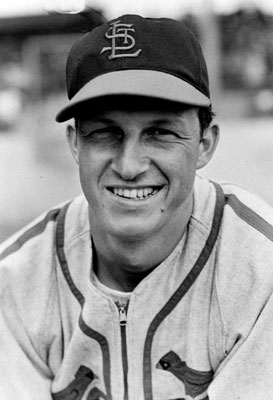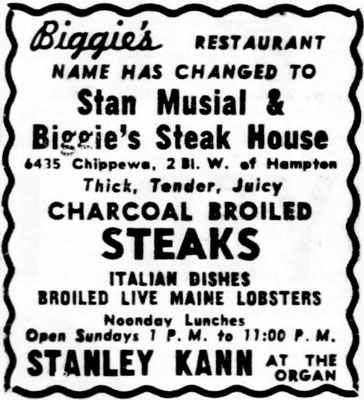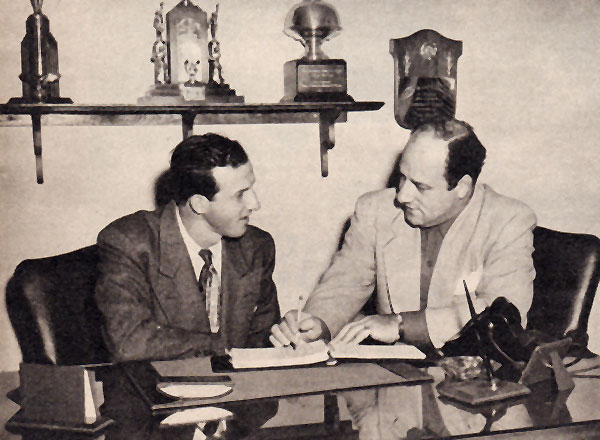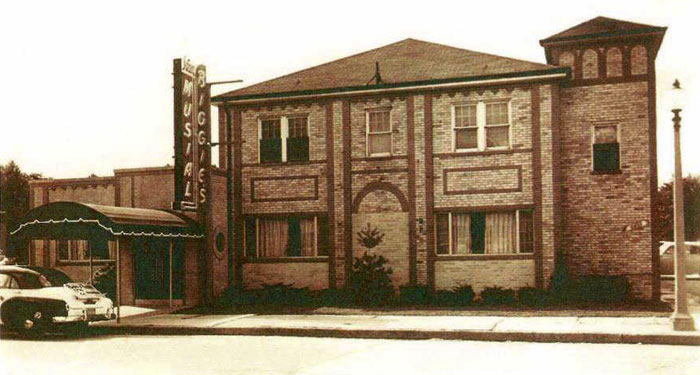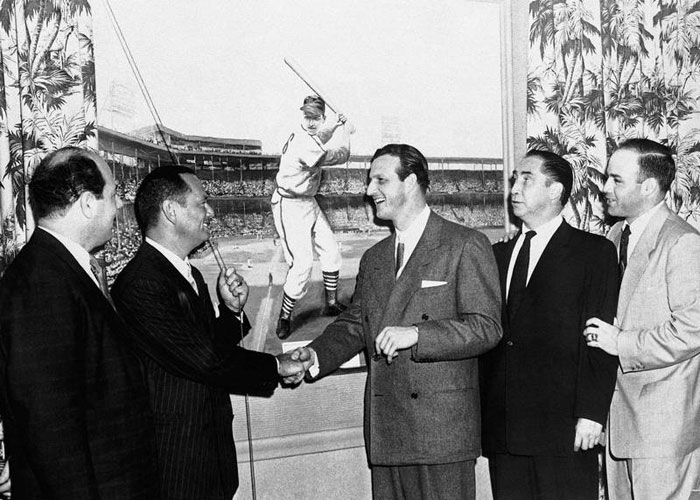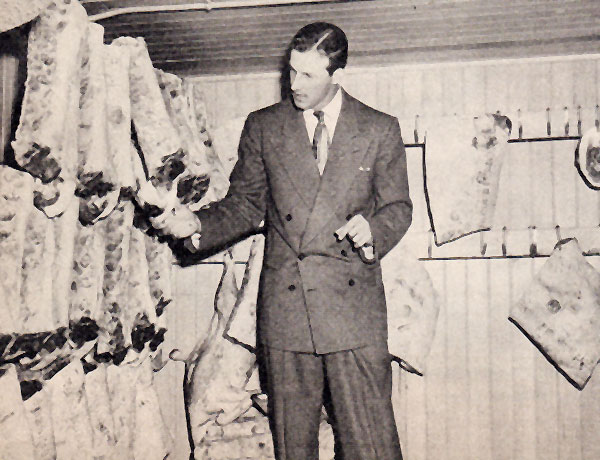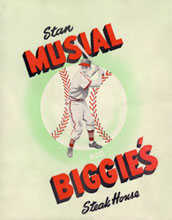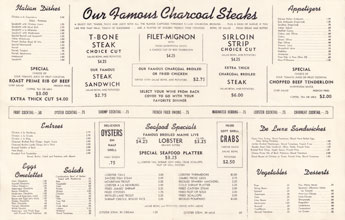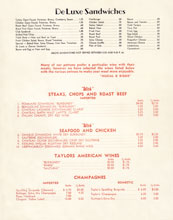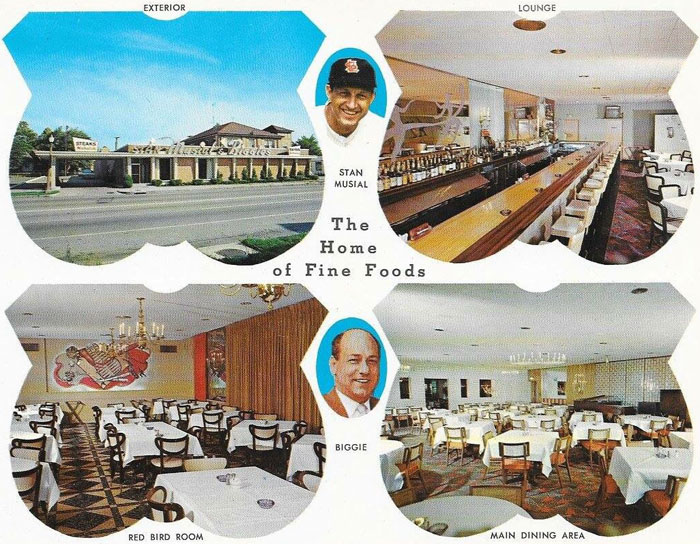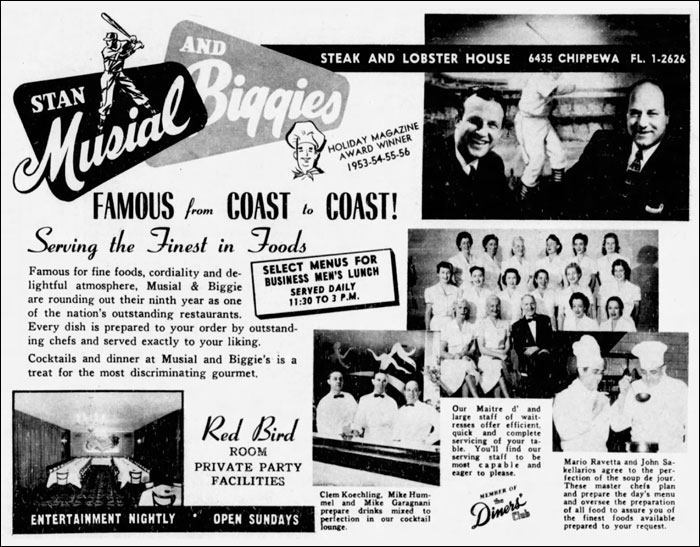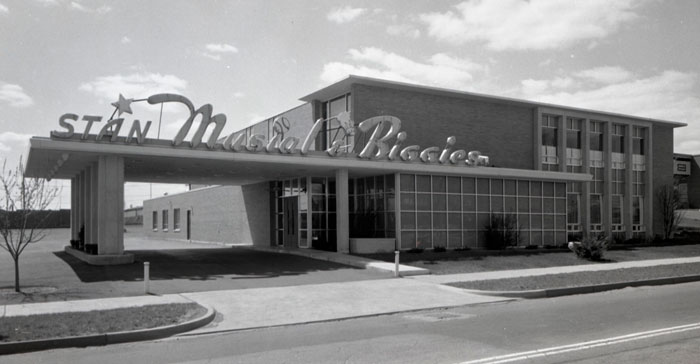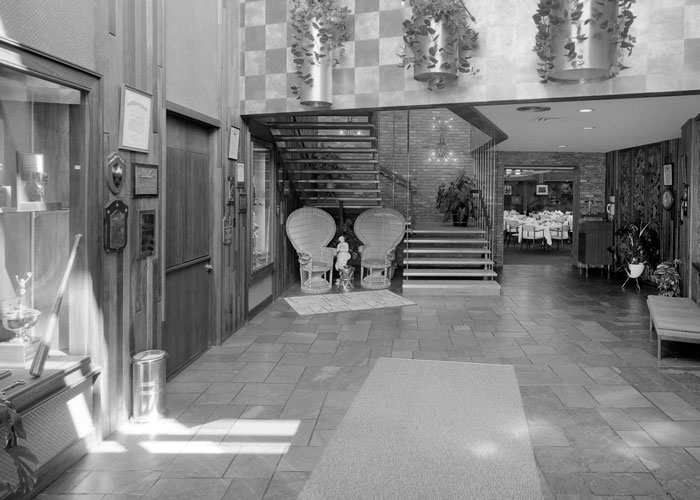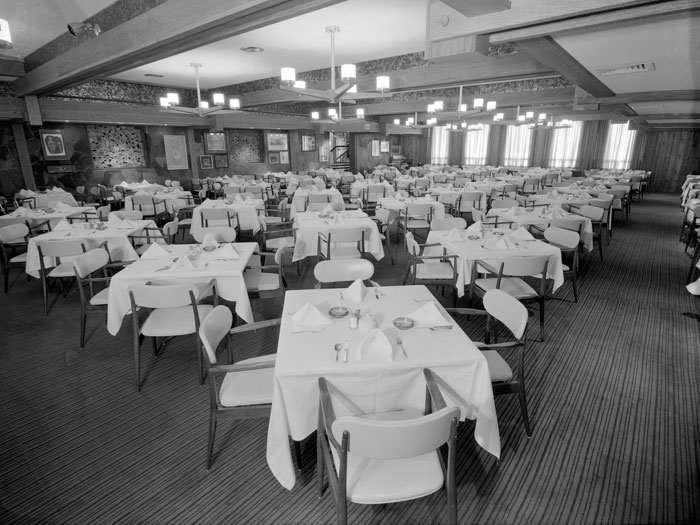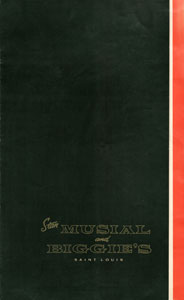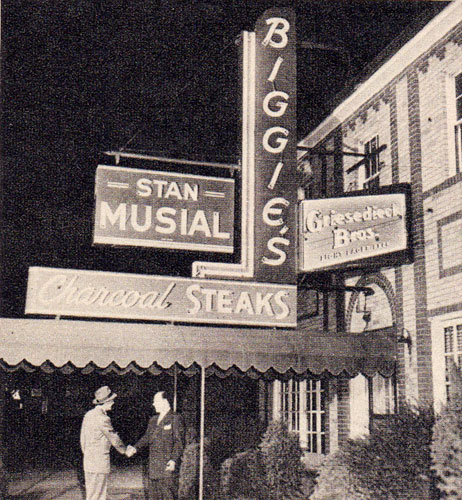|
Stan Musial & Biggie's Julius "Biggie" Garagnani, the son of an Italian immigrant miner, grew up on the Hill during the Great Depression. Born April 28, 1913, he left school following the fourth grade and worked odd jobs, including bootlegging, eventually driving a trash truck for the city of St. Louis.
Garagnani became involved in local Democratic
politics, serving as a precinct captain prior to his twenty-first
birthday. He emerged as a significant force in state
Democratic activities, especially in Warren Hearnes' gubernatorial
campaigns as a fund-raiser. Twice he attended the Democratic
National Convention as a delegate.
However, Biggie Garagnani did most of his stumping as a restaurateur.
Biggie and his brother Mike took over the
Brass Key, a nightclub at 5443 Magnolia, in the late 1930s. In
November of 1946, Biggie and Charles Re, his manager at the Brass
Key, took over Cafe 66 at 6435 Chippewa.
The steak house at 6435 Chippewa was soon
rebranded as Biggie & Charlie's and then Biggie & Charlie's Steak
House. Organist Stan Kann became a fixture at the restaurant in
early 1948. And by February of 1948, Charles Re had been bought out
and the restaurant became simply Biggie's Steak House.
In a July 1950 article in Sport magazine, Biggie Garagnani told sportswriter J. Roy Stockton how he met Stan Musial.
The star outfielder for the St. Louis Cardinals
began his major league career in 1941. However, until 1948, Musial
and his family spent the off season away from St. Louis at his
birthplace and home in Donora, Pennsylvania, about 40 miles from
Pittsburgh.
"In 1948, my wife and I decided to make our home in St. Louis," Musial recalled. "I think it’s wise for a baseball player to make his home where he’s made his reputation. I always worried about my baseball career, about getting hurt, and I wanted a business to fall back on." Biggie also remembered Musial wanting a home and a business in St. Louis.
However, Musial had just paid cash for his new home and had little capital to invest. Biggie was undeterred.
Biggie proposed that Musial's contribution would be $25,000, representing half of the restaurant's value. He suggested Musial, for his half ownership, compensate him from his share of the profits.
Musial officially became Biggie's partner in
January of 1949. But Musial was no
ordinary partner, as Biggie well knew. He sought to
capitalize on Musial's star status and enormous popularity, renaming
the restaurant Stan Musial and Biggie’s Steak House.
Biggie recalled that one of the first things Musial wanted was an office and a secretary.
Stan and Biggie’s, as the restaurant was popularly known, caught on. Fans could drive hundreds of miles for a ballgame and hope for a glimpse of Musial at mealtime.
With Musial attracting more and more customers,
business increased by 40 percent in the first year. In 1950, the restaurant
was enlarged, with the addition of a cocktail lounge and expansion of the
main dining room to accommodate 250 persons. The workforce increased from
fourteen to thirty-seven to deal with the new business.
Stan Musial & Biggie's featured Musial's presence on a limited basis during the baseball season and almost daily otherwise, a routine Biggie tried to moderate.
Musial visited tables and chatted with the patrons. He soon lost some of his shyness, enjoying the friendly conversation, especially with kids. He laughed easily at his own stories, contributing to the easygoing air that characterized the restaurant.
"In the first seven years Biggie and I were partners, the business went up $100,000 a year, every year," Musial recounted. "We’re both conservatives, we don’t like to go out on a limb, but we’ve got the same ideas, a lot. For instance, we change decor every three years or so. We always keep a baseball atmosphere, some of my trophies in front, but we change in the main room."
In 1953, Musial received an oil portrait of
himself for his restaurant. The portrait was a gift of fifty of his
St. Louis friends, headed by insurance executive Sidney Salomon.
Musial ensured that Biggie continued to use the highest quality of meats. Biggie said Musial always inspected the meat in the icebox and once complained because beef wasn't government stamped.
Musial had been a student of good eating places. Musial and Red Schoendienst, during their long years as roommates on Cardinal trips, were the National League’s authorities on good eating places in the league's seven other cities.
According to Biggie, one of the reasons Musial
was interested in being partners with him in the restaurant business
was his fondness for food. He contributed to the expansion of the
menu, adding more seafood dishes. Stan & Biggie's became a hangout for St. Louis athletes. "I had my first sour cream and chives on a baked potato at the old place," Cardinal catcher Tim McCarver recalled. "I was seventeen years old and didn’t have a clue about life or anything. "Stan put a lot of time in the restaurant," McCarver continued. "They weren’t open on a Sunday, but it was common in those days to play day games on Saturday and Stan was there after the game. The food was terrific." The restaurant did fabulously well in the 1950s. In January of 1952, Musial and Biggie purchased the Garavelli Restaurant on DeBaliviere Avenue, leased by August Sabadell, catering manger of the Hotel Chase. By 1954, they owned four eateries, the last of which was the Forest Park Hotel Snack Bar. In 1956, the restaurant at 6435 Chippewa was again enlarged. The original building was doubled in size, increasing capacity to 430 diners. The first phase of the work was the construction of a 21 by 90 foot wing at the west end of the building, which later was extended 11 feet to provide an entire new front. An enlarged lobby and an addition to the main dining room resulted.
A private dining room called the "Red Bird
Room" was added, with red velvet draperies and a mural depicting
Cardinal players and baseball scenes.
On February 17,
1961, a new Stan Musial & Biggie's formally opened at 5130
Oakland Avenue, adjacent to Highway 40 and across from Forest Park.
The restaurant on Chippewa had been closed, but was expected to be
renovated and reopened. However, later that year, Biggie leased the
building to Hurley Brady, who planned to open his own restaurant and
cocktail lounge in the space.
The elegant new
facility became one of the city's finest restaurants. Its lobby
featured Musial's memorabilia, including trophies and autographed
baseballs, reminders of his accomplishments.
The restaurant
featured a large main dining room on the first floor, which seated
225 patrons, and a cocktail lounge, which seated 84. The second
floor contained two private dining rooms, the Colonial which seated
300 and the Imperial which seated 175. These dining rooms hosted
numerous political events and became a favorite place for sports
banquets. Most Cardinal related social functions took place there.
Stan Musial retired as an active baseball player at the end of the 1963 season. The Cardinals made him a vice president, and he remained in the position until after the 1966 season. Before the 1967 season began, the Cardinals named Musial the team's general manager. Musial successfully juggled his restaurant business and his general manager duties until June 19, 1967, when Biggie Garagnani died suddenly of a heart attack at age fifty-three. Musial had relied on Biggie for his business acumen and psychic muscle. Now at a shockingly early age, Biggie was gone. Stan Musial and Biggie’s continued to thrive into the 1970s, with Biggie's son Jack becoming Musial's partner. In 1973, they acquired the St. Louis Hilton Inn near Lambert Airport and opened "Le Place de St. Louis" restaurant in the hotel. But the business began to decline as an aging Musial withdrew more and more from the day to day operations, including the iconic restaurant on Oakland Avenue. Stan Musial and Biggie’s restaurant served its last meal on New Year’s Eve of 1986. As Auld Lang Syne echoed through the building . . . so did Julius "Biggie" Garagnani.
Copyright © 2018
LostTables.com |

